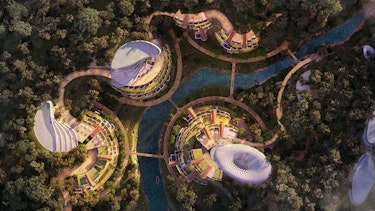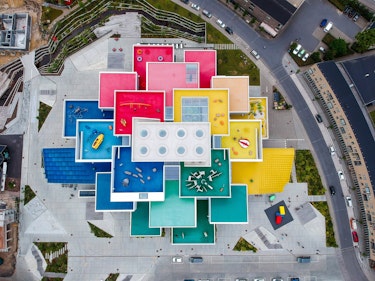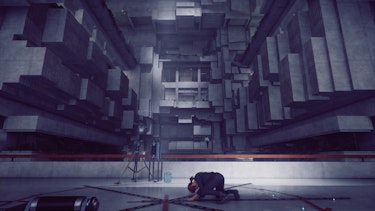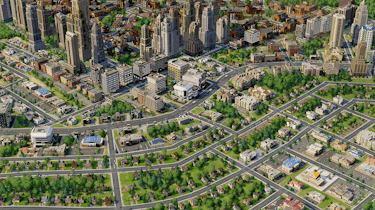The realm of gaming has undergone a remarkable transformation over the years, evolving from rudimentary graphics and basic gameplay to a multi-billion-dollar industry that not only entertains but also significantly influences various aspects of our lives. Among the myriad impacts of gaming, one of the most intriguing and profound is its pivotal role in the digitization of our built environment. In this article, we will embark on an extensive exploration of how gaming has shaped and continues to transform our physical surroundings.

Credit: ArchDaily
1. Virtual Worlds and Architectural Inspiration
Gaming has given birth to intricate virtual worlds that are often designed to mimic the aesthetics and functionality of real-life environments. These digital landscapes, cultivated in games like "Minecraft" and "SimCity," offer players more than just entertainment; they serve as a rich source of inspiration for architects and urban planners. The process of constructing and managing virtual cities in these games nurtures a deep appreciation for urban design and spatial organization.
One remarkable aspect of this interaction is how architects are increasingly turning to gaming as a wellspring of innovative design ideas. A striking example is the influence of "LEGO Universe" on the work of renowned architect Bjarke Ingels. The imaginative and playful world of this game left an indelible mark on Ingels' creative process, which is vividly evident in his design of the LEGO House in Denmark. This phenomenon underscores the dynamic synergy between gaming and architecture, where the virtual world not only informs but also enriches the physical one.

Credit: RTF
2. Visualization and Simulation
Gaming's proficiency in crafting visually stunning and immersive environments has catalyzed significant advancements in visualization and simulation technologies. Architects and developers have begun harnessing the power of real-time rendering engines to generate lifelike 3D models of buildings and urban spaces. These tools empower stakeholders to explore and interact with architectural designs before they manifest in the physical realm, mitigating costly errors and elevating the quality of decision-making processes.
Gaming technology offers architects the opportunity to create virtual environments that are indistinguishable from reality, down to the smallest details. This level of detail and realism facilitates not only the visualization of architectural concepts but also the ability to experience them. Such immersive experiences enable architects and clients to walk through spaces, exploring the play of light, texture, and materials as if they were physically present. This level of immersion fosters better understanding, communication, and decision-making, ultimately resulting in more successful architectural projects.

Credit: RTF
3. Data Integration and Smart Cities
In an era where cities are rapidly evolving into smarter and more interconnected entities, data takes center stage in urban planning and management. Gaming technologies excel in assimilating extensive datasets into digital renditions of cities. This data-driven approach aids urban planners in making informed decisions about infrastructure, transportation, and public services, ultimately leading to more efficient and sustainable urban environments.
Games like "Cities: Skylines" offer players a chance to grapple with the intricacies of managing traffic, utilities, and public services. These virtual urban laboratories provide valuable insights into the complexities of urban planning, informing real-world efforts to build smarter, more sustainable cities. The ability of gaming to simulate intricate systems and facilitate data-driven decision-making holds immense potential for the development of smart cities.
One of the key advantages of gaming technology in the context of smart cities is its ability to create dynamic, real-time simulations of urban environments. These simulations can incorporate a wide range of data sources, from traffic patterns and energy consumption to air quality and public transportation usage. By visualizing how different factors interact within a city, planners can make more informed decisions about infrastructure investments and policy changes.
Moreover, gaming technology allows for the creation of predictive models that can anticipate how a city will evolve over time. By simulating various scenarios and their potential outcomes, urban planners can develop strategies to proactively address challenges such as population growth, climate change, and resource allocation. This forward-thinking approach is crucial for building sustainable and resilient cities that can adapt to the evolving needs of their inhabitants.

Credit: Cities: Skylines
4. Collaborative Design and Virtual Reality
Virtual reality (VR) and augmented reality (AR) technologies, initially popularized by the gaming industry, are revolutionizing the way architects and designers collaborate and present their concepts. VR immerses stakeholders in architectural designs, enabling them to experience spaces as if they were physically present. This heightened level of immersion fosters more effective communication and understanding among project teams and clients.
The collaborative potential of VR is particularly evident in the design and construction phases of architectural projects. Architects, engineers, and clients can don VR headsets and enter a shared virtual space where they can interact with and evaluate design concepts in real-time. This collaborative environment allows for instant feedback, reducing the need for lengthy iterations and revisions in the design process.
Furthermore, AR applications can overlay digital information onto the physical world, greatly assisting in construction and maintenance tasks. For instance, construction workers can use AR headsets to visualize building plans while on-site, reducing errors and improving efficiency. AR can also aid in the inspection and maintenance of buildings by providing real-time data on structural integrity and system performance.
.webp?ixlib=gatsbyFP&auto=compress%2Cformat&fit=max&q=75&w=375)
Credit: Forbes
5. Preservation and Historical Reconstruction
Gaming's influence on the digitization of the built environment extends its reach into the realms of historical preservation and reconstruction. Games like "Assassin's Creed" are celebrated for their meticulous recreation of historical settings, offering players not only entertainment but also a platform for education and cultural preservation. These virtual reconstructions serve as invaluable references for architects and historians engaged in the restoration of historical buildings and sites.
Historical preservation often presents unique challenges, as buildings and monuments may have deteriorated over time or suffered damage from natural disasters or conflict. In such cases, accurate digital reconstructions created through gaming technology can be invaluable. By studying these virtual representations, architects and preservationists can gain insights into the original design and construction techniques, enabling them to plan restoration efforts with greater precision.
In recent years, organizations and institutions have harnessed gaming technology to establish digital archives of cultural heritage. These archives allow people to explore and learn about historical landmarks and artifacts from the comfort of their homes, thereby democratizing access to our shared history. Whether it's exploring the intricacies of the Parthenon in ancient Greece or walking the streets of Renaissance Florence, these virtual experiences provide a window into the past that is both immersive and educational.

Credit: GamesRadar
In conclusion, gaming's profound impact on digitizing the built environment is reshaping how we envision, plan, and experience our cities and structures. From inspiring architectural innovation to advancing visualization and simulation, gaming technologies have revolutionized multiple facets of the architectural and urban planning industries. As these technologies continue to evolve, architects, urban planners, and developers are embracing them to create smarter, more sustainable, and more engaging environments.
Moreover, gaming technology is not just a tool for professionals; it is increasingly becoming a means of civic engagement and cultural expression. Through gamification and interactive urban experiences, residents are actively participating in shaping the cities of the future. As gaming and technology continue to intersect with architecture and urban planning, we can expect a future where the boundaries between the digital and physical worlds blur even further, ushering in an era of innovation, connectivity, and sustainability in the built environment. The transformative power of gaming in shaping our cities is a testament to the enduring influence of this dynamic and ever-evolving industry on our lives and the world around us.
.jpg?ixlib=gatsbyFP&auto=compress%2Cformat&fit=max&q=75&w=375)